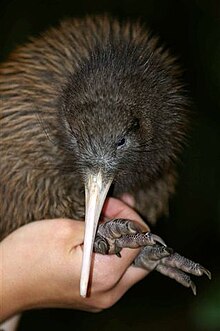Fauna of New Zealand

The


Because of the lack of predators, even bats spend most of their time on the ground. There are also about 60 species of
Some
Invasive species
Humans first arrived via the Pacific islands, in several waves at some time before 1300 AD,
In recent years,[
See also
| Part of a series on |
| Biota of New Zealand |
|---|
 |
- Fauna
- Birds of New Zealand
- Butterflies of New Zealand
- Crabs of New Zealand
- Frogs of New Zealand
- Geckos of New Zealand
- Mammals of New Zealand
- Non-marine and marine molluscs of New Zealand
- Reptiles of New Zealand
- Spiders of New Zealand
- Stick insects of New Zealand
- Other
- Animal welfare in New Zealand
- Biodiversity of New Zealand
- Invasive species in New Zealand
- Flora of New Zealand
References
- .
- ^ "Rat remains help date New Zealand's colonisation". New Scientist. 4 June 2008. Accessed 2008-06-23
- ^ T. T. Veblen and G. H. Stewart (1982). "The effects of introduced wild animals on New Zealand forests". Annals of the Association of American Geographers, Vol. 72, No. 3, pp. 372 397.
Further reading
- King, Carolyn M.; Barrett, Priscilla (2005). The Handbook of New Zealand Mammals. Oxford University Press. ISBN 9780195584776.
External links
- Native animals at the Department of Conservation
- Fauna of New Zealand Archived 2012-05-11 at the Wayback Machine at Landcare Research
- Animals databases Archived 2012-05-27 at the Wayback Machine at Landcare Research
